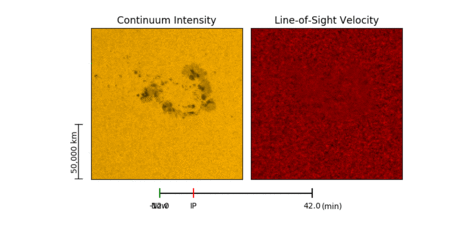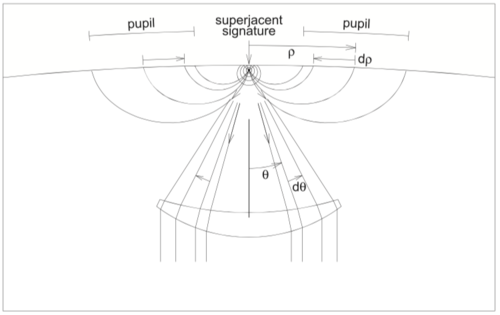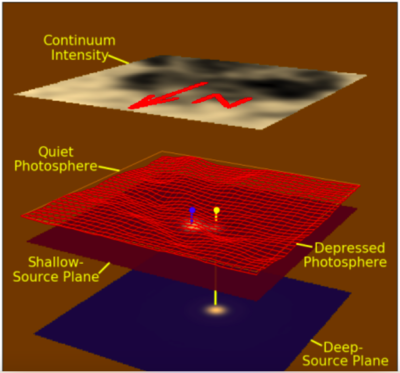Submerged Flare Acoustic Sources
From RHESSI Wiki
| Nugget | |
|---|---|
| Number: | 388 |
| 1st Author: | Juan Camilo BUITRAGO CASAS |
| 2nd Author: | Angel MARTÍNEZ |
| Published: | 13 September 2020 |
| Next Nugget: | Flare/CME Cartoon Archive |
| Previous Nugget: | Circular Ribbon Flare at Microwaves |
| List all | |
Contents |
Introduction
A major new discovery about solar flares appeared as recently as 1997, when a set of concentric, expanding ripples appeared on the solar surface immediately following the flare SOL1996-07-09 (see earlier Nuggets No. 26 and No. 127). These phenomena hold great interest because they come from acoustic waves launched by the flare that surprisingly penetrate into the Sun's deep interior, and that contain substantial fractions of the flare's total energy. At present no broadly accepted theory exists.
These events are hard to detect because the ripples have small amplitudes, comparable in fact to the ubiquitous photospheric variability due to convection and the "p-mode" global oscillations. Recently an extraordinarily impulsive flare, SOL2016-07-23, produced an acoustic event that has led to the discovery described here (Ref. [2]). Figure 1 shows one frame from a [movie] that shows the development of the ripples.

Solar Acoustic Holography
This subject may sound forbiddingly arcane, but in essence it is simple: one observes the ripples, and then propagates them analytically back through the solar interior, knowing the speed of sound everywhere, until the rays converge on the source region and thus image it. The analogy with optical ray tracing is not exact; see Ref. [3] for more discussion of the holography. Figure 2 is a rough schematic of how images are formed; the source location (and its shape) can be determined in all three dimensions.

For this flare the source is quite compact, close to the resolution limit imposed by the diffraction of the acoustic wave front, and (surprise!) at a significant depth below the photosphere (Ref. [3] estimates 1150 +- 200 km). Figure 3 illustrates the layout of the forward-fitting computation with source planes at different depths.
Conclusion
The novel result here is that the acoustic source was submerged, at a finite depth below the photosphere. This implies that sufficient energy to drive the seismic waves, which may amount to 0.1% of the total flare energy, must find its way into the interior through a medium with low wave speeds (few km/s). And how can this large energy suddenly appear in such a small volume? On top of that, as described in Ref. [3], the source location does not obviously relate to the flare structures as seen in the "continuum intensity" plane of Figure 3.
These questions challenge our knowledge of the sub-photospheric domain of a solar active region and we are grateful for the "pings" launched by solar flares, as an aid to our understanding.
Acknowlegements
Alina Donea, Hugh Hudson, Charles Lindsey, and Juan Carlos Martínez Oliveros contributed to this Nugget.
References
[1] "X-ray flare sparks quake inside Sun"
[2] "Ultra-impulsive Solar Flare Seismology"
[3] "Submerged Sources of Transient Acoustic Emission from Solar Flares"
| RHESSI Nugget Date | 13 September 2020 + |
| RHESSI Nugget First Author | Juan Camilo BUITRAGO CASAS + |
| RHESSI Nugget Index | 388 + |
| RHESSI Nugget Second Author | Angel MARTÍNEZ + |
